Engineer: Difference between revisions
Studenterhue (talk | contribs) →Engineering a Disaster: Treachery: Generalize a few parts of this to antag engie in general, not just Traitor. Mostly just swapping some words since a lot of this was already applicable to engie in general |
Studenterhue (talk | contribs) m →Engineering a Disaster: Treachery: rename subtitle to "Antagonist Engineer" to make it extra clear this is for when you're antag |
||
| Line 156: | Line 156: | ||
Another bad idea for Engineers is making and wearing Stungloves. To make a pair of Stungloves, take a pair of insulated gloves and use wiring on them. Then use a power cell on the the Insulated Gloves to charge them; you can have up to four charges. If you wear them and do a [[Murder#Special Attacks|special attack]] while unarmed, you'll throw sparks that drain people's stamina and make it harder for them to move. This sounds great (and it is), but stun gloves have an extremely obvious sprite and sometimes Security Officers will deem them as a weapon and arrest you to get them. If you do make some Stungloves, keep them in your backpack until things start blowing up. After there's been a few murder reports, even the most fascist Security Officers will be too busy to care about your gloves. | Another bad idea for Engineers is making and wearing Stungloves. To make a pair of Stungloves, take a pair of insulated gloves and use wiring on them. Then use a power cell on the the Insulated Gloves to charge them; you can have up to four charges. If you wear them and do a [[Murder#Special Attacks|special attack]] while unarmed, you'll throw sparks that drain people's stamina and make it harder for them to move. This sounds great (and it is), but stun gloves have an extremely obvious sprite and sometimes Security Officers will deem them as a weapon and arrest you to get them. If you do make some Stungloves, keep them in your backpack until things start blowing up. After there's been a few murder reports, even the most fascist Security Officers will be too busy to care about your gloves. | ||
==Engineering a Disaster: | ==Engineering a Disaster: Antagonist Engineer == | ||
[[Antagonist]] Engineers often choose to wreak a little havoc using the [[AI]] as an assistant. With easy access to tools and gloves, you can easily break in to the [[AI Upload]] and give it a law that'll send it on a bloody rampage. You'll have to careful around the stun turrets (which you can't turn off), but they're easy to dodge if you're fast enough. (If you're not, throw a [[Engineering Objects#Metal Foam Grenade|foam grenade]] into the upload to block them off.) To seal the deal, take the Reset module and AI Upload circuit board in the [[Computer Core]] and [[Construction#Console|deconstruct]] the [[Computers#Robotics Control Computer|Robotics Control Computer]], so the crew can't reset or killswitch the AI. | [[Antagonist]] Engineers often choose to wreak a little havoc using the [[AI]] as an assistant. With easy access to tools and gloves, you can easily break in to the [[AI Upload]] and give it a law that'll send it on a bloody rampage. You'll have to careful around the stun turrets (which you can't turn off), but they're easy to dodge if you're fast enough. (If you're not, throw a [[Engineering Objects#Metal Foam Grenade|foam grenade]] into the upload to block them off.) To seal the deal, take the Reset module and AI Upload circuit board in the [[Computer Core]] and [[Construction#Console|deconstruct]] the [[Computers#Robotics Control Computer|Robotics Control Computer]], so the crew can't reset or killswitch the AI. | ||
Revision as of 06:52, 9 July 2021
| ENGINEERING DEPARTMENT | |
|---|---|
| Engineer | |
 Engineer |
Difficulty: Easy to Medium Requirements: None Access Level: Engineering, Maintenance Additional Roleplay Access Level: None Supervisors: Chief Engineer, Captain Subordinates: None Responsibilities: Conduct structural and electrical repairs, configure the solars (space-based maps), setup and maintain the thermo-electric engine (Atlas/Clarion/Cogmap1/Cogmap2/Destiny/Horizon/Kondaru) / singularity engine (Donut 3/Manta) / geothermal system (Oshan) in Engineering Guides: Powering the station, Construction, Guide to Wiring, Gas, Engineering Objects |
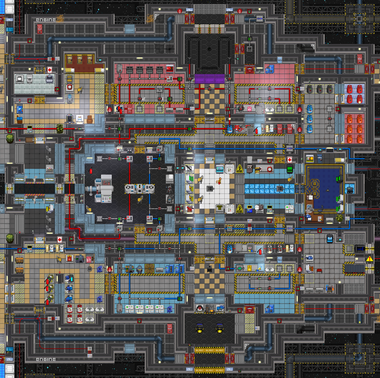
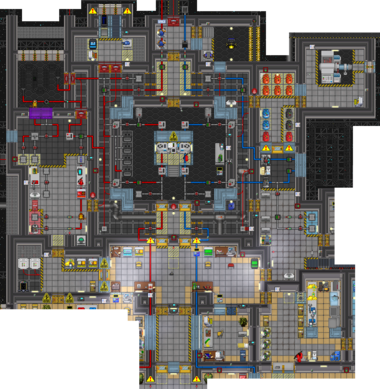
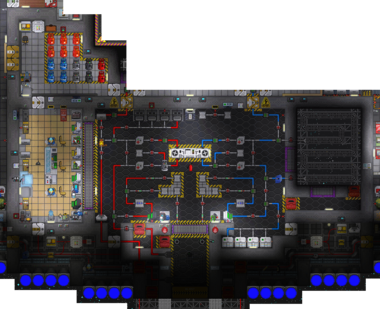
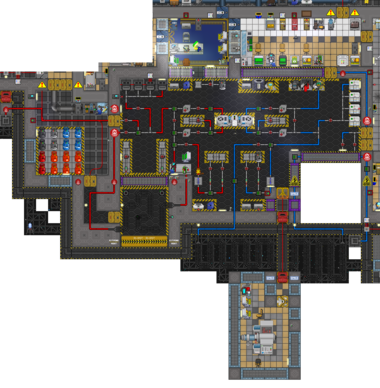
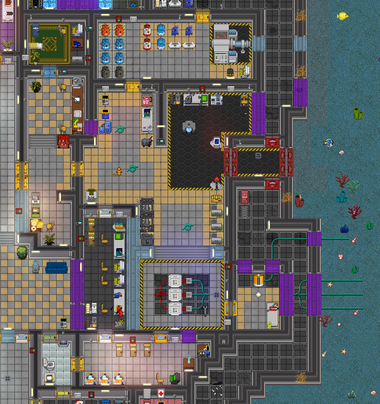
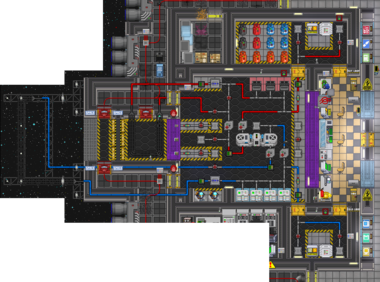
Trust yourself, you're an Engineer. You start in Engineering with an epic array of gear, tools, and materials at your disposal and the equally epic responsibilities of starting the engine in Engineering and repairing and renovating the station. Both tasks may cause side effects such as horrific burns, rapid suffocation, and death.
Power to the People
- Main article: Powering the station
Generation
There are a plethora of ways to generate power, each with their own intricacies and subtleties, but as an Engineer, you're primarily concerned with the engine in Engineering. Depending on the map, that engine is either the Thermo-Electric Generator or the Geothermal Capture System.
The Thermo Electric-Generator
Cogmap1, Cogmap2, Destiny, and Clarion's main means of generating power. This page section will give you a primer on how to get the engine running. Short version:
- Get any gas flowing in the two gas loops that meet in the Thermo-Electric engine in the middle of Engineering.
- You want the top loop to be real hot and the bottom loop to be real cold. The temperature difference is what generates power. People usually focus on heating the hot loop.
- The hot loop can be heated by connecting hot gas to the loop in the first place, by burning fuel in the furnaces, or by getting a fire running in the combustion chamber.
- The cold loop mostly cools itself by a coil exposed to space, or can be cooled with freezer units.
- Be careful with pressure. Get it too high, and the pipes will burst.
- Minimum pressure can be set on circulators with a multitool to the left and right of the engine.
- Don't forget to open valves as needed to get the gas going where it needs to go.
- Don't forget to set the SMES units.
It's probably going to be a little intimidating at first, but it's not so bad once you get used to it. Learning it is a lot easier and overall better if you have a fellow Engineer helping you every step of the way or a Mentor guiding you through. This is true with a lot of things, but it's especially so in this case.
The Singularity
On Manta, instead working in a blistering-hot hell-inferno like those other stations and ships, you work six feet from the edge of a bottomless abyss, using the power of the void to keep the lights on. This page section will give you the rundown on how to harness the all-consuming empty and setup the singularity. Short version of that:
- Secure down the emitters, field generators, collection arrays, array controllers, and singularity generator in their proper positions, using wrenches and welders.
- Turn on the emitters, then the field generators. The emitters will shoot beams at and transfer power to the field generators, and the field generators will create a containment field that keeps the singularity in place. Remember that the Engine Control Computer can turn the emitters and field generators on for you. (By the way, the shield generator by it has nothing to do with the singulo engine.)
- If the field generators are the proper distance apart and creating containment beams, the singularity generator should automatically collapse into a singularity. The singularity has an immense gravitational pull and occasionally releases various types of radiation, so take some proper precautions.
- Don't forget to put plasma tanks from the tank dispensers into the collection arrays and to turn on the collection arrays and array controllers, which are what actually generate power.
- Don't forget to set the SMES units.
- Feeding people, monkeys, and items into the singularity permanently boosts its power output, with people and monkeys providing much more than items.
Rather cookie-cutter, but at least it means you'll have the freetime to complete repairs, do renovations, and other things. If you flub up, you might release a loose singularity, but as long as you double-check everything's properly secured before starting anything and activate emitters before field generators, you'll be fine.
The Geothermal Capture System
If you're working on the Oshan Laboratory, you better check underneath the sea(floor), because that's where you will find the energy! Anyways, dumb Sealab 2021 references aside, on Oshan Laboratory, you'll be using the geothermal energy on Abzu's seafloor to generate electricity. This section will tell all about how to set it up and improve it. Here's the short version of it:
- The system generates power via geothermal vent units placed over the centers of hotspots, where it's hottest and thus produces the most power.
- You find these hotspots and locate their centers, you need place down (and pick up) dowsing rods and look at their readings. Redder/pinker colors indicate higher temperatures; lower numbers indicate closer distance to the center of a hotspot. As a hotspot drifts, it will drag any placed dowsing rods in its range along with it.
- Dowsing rods are also affected by Doppler shift, so there some places that say they're closer to the center than they actually are and some that say they're farther.
- Once you've located the center of a hotspot, lock it in place with a stomper unit. Then, dig a hole into it with a power shovel, build a vent capture unit on it, and wire it back to the station. There are boxes of wire in the crates
- To generate more power, you can move hotspots closer together so they generate more heat, dig out the rock in the hotspot's corresponding location in the trench to release the energy trapped underneath, or just build more holes and vent capture units around a vent capture spot.
- Don't forget to set the SMES units.
All the tools you need will either be in Engineering Storage or the general Engineering foyer section near the double-door-sized airlock leading into the seafloor, kept either in the open or inside crates.
Solar Panel Arrays
The more passive, easy-going companion to the engine, and the backup power supply if the engine breaks. Every map except Oshan Laboratory (for obvious reasons) has these. They're pretty much maintenance-free once the SMES units are set up or the solar panels are hotwired (i.e. the wires go from the solar panels straight to the station, rather than going through a SMES). However, if the wiring for the solars breaks for any reason, repairing it falls under your responsibility. Be sure to head over to the relevant page section to learn the correct SMES configurations and/or tips on hotwiring the solars.
Power Distribution
Once the engine is up and running, and the solar arrays are receiving starlight, the power generated by the engine then goes through wires connected to SMES units, which distribute a configured amount of power throughout the station to APCs, which control the machines, lights, and other immobile electrical devices in their designated rooms.
SMES Cells
Superconducting magnet arrays that use the principle of electromagnetic induction to store energy. Charging these to full isn't really a top priority, but the rest of the station receives power from these SMES units, so properly configuring them is important. The precise numbers are different for each station and engine setup, but a good configuration setting is little under half of the engine's output as SMES input (to counter fluctuations), and half of that as SMES output (to charge the SMES).
With some fairly basic wiring knowledge, it is possible to bypass the SMES units altogether, a practice known as hotwiring. Hotwiring generally means the station is receiving more power at higher safety risk, which scales with the amount of power being generated. Hotwiring the solars arrays is almost always safe, with hotwiring the singularity or a basic low-power thermo-electric generator setup being slightly more dangerous. Hotwiring an advanced TEG setup that generates tens or hundreds of MW and more, however, is very likely to overload the station power network, potentially causing APCs to spontaneously shock people and electric shocks to seriously hurt, so you generally shouldn't do that unless you're an antagonist.
APCs
Area power controllers, white panels with lots of little lights that control electricity coming into an area. If you've set up the engine correctly, then these should be receiving power. You'll know because they'll say "Good" in green-colored font. If they say "Low" or "None", you might want to check up on the SMES units or make sure the wiring leading to the APC is intact.
You don't necessarily need to touch them when setting up the engine, but you might need to mess with their settings after an ion storm has hit the station or after a power sink has been deployed and you need to get stuff back online. See this page for info on their settings.
Power Transmission Laser
A treat for good Cogmap1, Cogmap2, Clarion, and Oshan Laboratory Engineers. Once you have the engine running, consider routing some of your extra watts into the power transmission laser. Not only does it output power as a frickin' laser beam, but said laser also puts money into the Payroll budget while it's powered! It takes some micromanagement, but if you can set it up right, you can make millions of credits every minute and earn the favor of the entire station, especially if you donate a share of the earnings to the Quartermaster's Cargo budget. Just keep a close eye on the input depriving any departments of power in the process.
Power Checker 0.14
Luckily, you don't have to shut yourself in Engineering and watch the monitors all round. All Engineer PDAs come with the program Power Checker 0.14, an app that gives you important information about the engine. For the thermoelectric generator, it shows you the same statistics as clicking on the TEG unit itself would: engine output and temperature and pressure at cold loop inlet, cold loop outlet, hot loop inlet, and hot loop outlet. For the singularity, it shows the power output of each radiation collector and the pressures of the plasma tanks within each one. Finally, for the geothermal capture system, it show the output of vent units. In this way, you can check in on the engine on the go as you go and actually fix things on the station.
It also shows you various stats about the PTL, including vital statistics such as power input, power stored in PTL, output, etc., if your map has one.
Repairing the Station
- Main article: Construction#Walls, Doors, and Floors
The Engineering department's other real job is repairing hull breaches and damage. To rep, you'll require a stack of metal. Though it's technically not required, you'll also want a space suit and an air tank-breath mask combo. All these can be found in Engineering Storage and, if your station/ship has one, Engineering Pod Bay.
Thanks to starting with the Engineering Training trait, constructing/deconstructing certain structures and objects, such as windows, take only half the time. Shame it doesn't work with Carpenter though.
Flooring 
If there isn't a stack of floor tiles, click on a stack of metal while it's in your hand to bring up the construction window and select Floor Tiles. The precise number of tiles you'll need to make depends on the situation. Don't fret about making too little, as you can easily make more, or too many, as the extra tiles can potentially be reprocessed back into sheets, and sheets themselves are often plentiful and easy to make.
To repair the breach, simply click on the space tile or lattice with the floor tiles in your active hand to create some flooring. Once totally sealed, garnish with space HVAC units so people can walk through the area without slowing to a crawl.
If you want the area to look like it didn't totally just explode, you'll want to learn how to replace broken floor tiles. To do this, just use a crowbar on the tiles that look burned, and then replace them with new floor tiles. It's not really an important skill to have, but it does make the station look less like a death trap.
Walls 
You may also need to make walls to fully seal a breach. To do this, you'll require a stack of metal (and optionally rods).
First, you need to build a girder, either by clicking on the stack to open the metal's construction window and selecting Wall Girders or by simply clicking on a tile with sheets in your active hand. Once the girder's built, use metal on it to form a wall. You can also use reinforced metal for the plating, which you can make by combining regular metal sheets and rods. If you want to make a false wall, use a crowbar on the girder first to dislodge it, then apply the plating.
Windows 
While you're at it, you should also repair any broken windows. It's easy. Similar to metal sheets, clicking on a stack of glass sheets in-hand opens up a construction window with the choices of large and thin windows. Most of the time, you'll be choosing large windows, simply because large windows are more common, but there are places that use thin windows.
Windows with grilles are even easier. If the grille's still there (it doesn't matter how broken it is), you can just click on the grille while holding glass sheets of any kind to put a full-sized window over it. If the grille's gone, but there's still some bit of grille leftover, just click on a stack of rods while standing over the broken grille to repair it, then do the previously-mentioned steps. If the grille's completely gone, construct a new grille by clicking on a stack of at least two rods, then construct the windows are previously mentioned.
Repressurizing 
Now, once you've fully sealed the breach, you might want to repressurize the room so that people aren't suffocating and gasping for air as they walk through the place. If the room has an Emergency Air Hookup for it, you can just connect the air canisters to the relevant ports and turn the relevant valves.
If not, you'll have to manually refill the air by bringing in some air canisters. Don't just open it and leave it out in one spot; all the air will accumulate in that one spot rather than spreading out. Instead, set the canister to a fairly high (600 kPA or more) and move the canister every few seconds so the air is (hopefully) evenly distributed through the room. Scan the room tiles with an atmospheric analyzer every so often, and make sure there's at least 85 kPa of air mix (or at least 17 kPA of oxygen) on each tile.
Lighting, Wiring, and Piping 



While you're at it, you should also replace the light tubes and bulbs. It's pretty straightforward. Just grab a few replacement light tube/bulb boxes from Engineering Storage (or make them using the fabricator in Tool Storage), take one of the tubes/bulbs out of the box, and click on the tube/bulb you want to replace. Plain light tubes and bulbs are fine, but if you want to, you can opt for colored lights and turn the room into some sort of swanky Christmas-themed nightclub/love-shack.
If things get really bad, you might also need to replace the wiring. As always, Engineering Storage has plenty of wires, usually in either cable coil boxes or electrical toolboxes. Be sure to check out the Guide to Wiring for a primer on the fundamental principles of wiring. Don't fret too much about replicating the original layout. Just make sure there's a complete link with the rest of the power network.
If you have the time, you might also want to replace any broken disposal piping. To start your pipelaying adventure, you'll need to obtain a welding tool and drag the disposal pipe dispenser cart over to where you want to work. Use the welding tool to melt away any broken disposal piping sections. Once you've placed the particular pipe you need in the proper position, use the welder to secure it on the floor. Don't worry about getting the layout right. Just make sure there's a complete link. If you make a mistake, simply unweld the pipe from the floor.
Now What?
Once it's set up, one person can handle the engine safely, and most of the time, there are no hull breaches. So, it's time to get up to some mischief, since you've got nothing better to do. To start with the basics, Door Hacking. You'll need a multitool, a screwdriver, insulated gloves, and a crowbar. A wirecutter could also come in handy. Open the door's faceplate with the screwdriver, then click with an empty hand. A window will come up. Minimize it and take out your multitool. The window will show a bunch of wires with buttons for Cut, Pulse, and Attach Signaller on them. Start from the top, and begin pulsing wires. Pulse each one once. There are notifications at the bottom for Power, Bolts, and AI control. If you trigger a Power wire, you can use the crowbar on the door to open it. Power will be down for 10 seconds, and then backup power will trigger. Pulsing the backup power wire will disable it for 1 minute. If the bolts go down, then the door can't be opened. Pulse the same wire again to undo the bolts. The Bolts can go down at all times, but can only disengage if the power wires are operating. If you accidentally hit the bolts when the power is down, you might have to wait a minute to continue. It's also a good point that an engineer who is well versed in how hacking doors work, when provided the tools to do so have effectively all access to any portion of the station they wish. Nothing is better at stopping a corrupted AI than an insulated glove wearing Engineer who knows his stuff.
Another bad idea for Engineers is making and wearing Stungloves. To make a pair of Stungloves, take a pair of insulated gloves and use wiring on them. Then use a power cell on the the Insulated Gloves to charge them; you can have up to four charges. If you wear them and do a special attack while unarmed, you'll throw sparks that drain people's stamina and make it harder for them to move. This sounds great (and it is), but stun gloves have an extremely obvious sprite and sometimes Security Officers will deem them as a weapon and arrest you to get them. If you do make some Stungloves, keep them in your backpack until things start blowing up. After there's been a few murder reports, even the most fascist Security Officers will be too busy to care about your gloves.
Engineering a Disaster: Antagonist Engineer
Antagonist Engineers often choose to wreak a little havoc using the AI as an assistant. With easy access to tools and gloves, you can easily break in to the AI Upload and give it a law that'll send it on a bloody rampage. You'll have to careful around the stun turrets (which you can't turn off), but they're easy to dodge if you're fast enough. (If you're not, throw a foam grenade into the upload to block them off.) To seal the deal, take the Reset module and AI Upload circuit board in the Computer Core and deconstruct the Robotics Control Computer, so the crew can't reset or killswitch the AI.
The power transmission laser can also reach insane levels of power if enough watts are being sent out, to the point that contact causes immediate, absolute disintegration. The flow of the laser is fixed, so you can only take advantage of it in particular places, but it makes for excellent corpse removal and a nice way of executing any stunned or unconscious victims.
With some good engineering knowledge and hotwiring skills, an antag engineer can hotwire the engine directly to the power grid (exactly where will vary from map to map) and weaponize the engine itself. Hotwiring an sufficiently powerful (25 MW or more is a good start) thermo-electric generator setup will overload the station's power network, causing APCs all across the station to spontaneously shock people, stunning them and inflicting burn damage. The greater the power output, the nastier the shocks. This is great way to wreak havoc and sow chaos across the whole station. Just be careful not to get shocked yourself; the APC shocks will bypass your insulated gloves.
Even better, hotwiring also increases the burn damage of electrified doors. If you hotwire a sufficiently high power engine (~55-60 MW), electrified doors will to outright gib people who aren't sufficiently protected. With some good knowledge of door wiring or a subverted AI, you can kill people simply by having them open the wrong door, while the APCs all over the station rain down nasty electric shocks on everyone.
Engineers also make great bombers. Engineering comes with all the welding fluid, metal sheets, and wire you need for to rain pipe bombs upon the station, plus plenty of extra items for unique and deadly effects. Plasma from the hot loop is great for making bomb mixes, especially if you have a good burn going in the combustion chamber. You can siphon it off for your TTVs and single tank bombs simply by wrenching an empty canister (or air pump with plasma tank) onto any of the hot loop ports.
Given all this, the job-specific Syndicate Items for Engineer seem almost like slim pickings. Traitor Engineers can get a syndicate cargo transporter for disposing of containers of evidence (and potentially people) far, far away, and a set of power gloves for shooting electricity from their fingers, like a Zeus or Palpatine in yellow. On the more gimmicky side of things, they can also order a pickpocket gun, a battery-based contraption that can steal items, including ID cards, from people or plant things on them. It also does a variety of slapstick antics depending on which body parts you aim it at.
Supplementary Video
| Jobs on Space Station 13 | ||
|---|---|---|
| Command & Security |
||
| Medical | ||
| Research | ||
| Engineering | ||
| Civilian |
| |
| Silicon | ||
| Jobs of the Day | ||
| Antagonist Roles | With own mode | |
| Others | ||
| Special Roles | ||